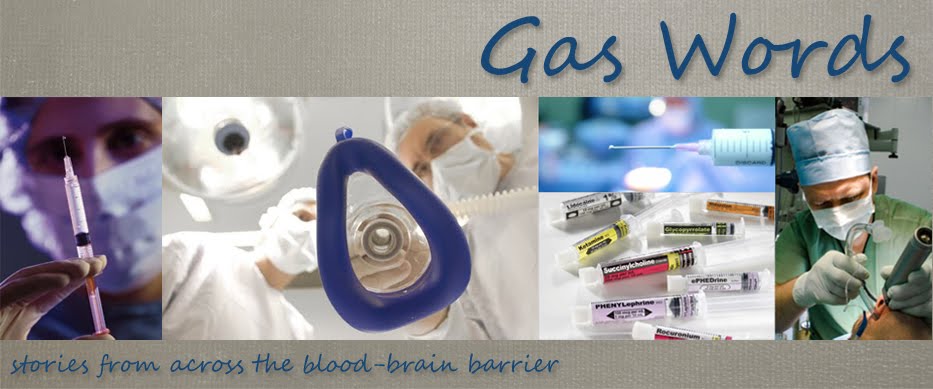I was a third-year medical student on my psychiatry rotation when a series of events began that would ultimately alter the course of my life. It started with a middle-aged woman with schizophrenia who complained of severe low back pain. Well, I thought, even paranoids can have enemies, and even schizophrenics can have legit back pain. I acquired an MRI performed on the patient during a previous incarceration and placed a consult with the Acute Pain Service.
The resident who came to see my patient was a soft-spoken Filipino man. He thoughtfully evaluated my patient, then wrote a note providing recommendations for management of her pain. Afterward, he sat in the residents' workroom with me.
"What do you want to do with your life?" he asked.
I had my answer ready. "I want to be a surgeon."
He smiled. "I wanted to be a surgeon once, too. Do yourself a favor, and do one elective in anesthesiology. You may love it, in which case thank me later. If you still become a surgeon, you'll be a better one because you'll know what happens on that side of your patient. And if you do anything else, you'll still learn how to start IVs, mask ventilate, and intubate, and those are useful skills for any physician to have."
His advice made sense, and four months later I found myself on an elective anesthesiology rotation at the public hospital across town. For the first two weeks, I enjoyed the specialty's combination of applied pharmacology and procedures. But it was during my third week on service that the course of my life changed.
The event that changed my life began when my attending received a page from the OR control desk. "Dr. Evans," said the head nurse, "General Surgery has posted an emergency ex lap on a patient in the ICU. They think he's hemorrhaging. They say we should treat it like a trauma. Our trauma room is OR 12."
My attending started walking down the hall as he called an available senior resident. "Steve? A patient from the unit is bleeding out. Set up room twelve for trauma."
Within minutes, Dr. Evans and I were running alongside an ICU bed getting information from the surgery team. The patient was a 50-something male with a history of alcohol abuse who'd been admitted to the hospital with Mallory-Weiss tears. He'd been stably ill in the ICU for a day but had acutely decompensated that morning.
We arrived in the OR where Steve was ready to receive the patient. He'd enlisted the help of Megan, another senior resident, and activated the hospital's massive transfusion protocol. The OR became a blur of action as we moved the patient to the OR table, attached monitors, and started high-flow oxygen. The patient looked terrible: heart rate in the 160s, blood pressure of 50s/30s, and altered mentation, all consistent with hypovolemic shock. Dr. Evans administered scopolamine and rocuronium through the patient's IV, I applied cricoid pressure, and Steve intubated the patient. I noticed that nobody turned on any volatile anesthetic for maintenance anesthesia. Megan leaned over and explained, "He's too shocky. Gotta make him earn his gas."
The next hour was a blur. The surgeons opened the patient's abdomen and found that he had nearly exsanguinated from his left gastric artery. They stopped the bleeding, then searched through his abdomen for any additional sources of hemorrhage. But I hardly noticed them, so enthralled was I with the anesthetic dance that unfolded before me. For a dance it was, with the three anesthesiologists coordinating their efforts to thwart death as it sought to claim our patient. There was no wasted movement. There were no wasted words. There was no duplicated effort. Steve, Megan, and Dr. Evans danced around and with each other to administer drugs, transfuse blood, draw labs, evaluate and adjust, evaluate and adjust. They put me to work as their go-fer, running between the OR and the lab, the pharmacy and the blood bank, retrieving the precious information and materials with which they would save a man's life.
As quickly as it had begun, the dance ended. The surgeons had controlled the bleeding, closed the patient's abdomen, and applied clean white dressings to his wound. We moved him back to his ICU bed, made up during the case with fresh linens by the attentive housekeeping staff, and began the long journey back to the ICU. The patient was critically ill, but alive. We gave report to his nurse, then gathered our equipment and returned to the OR suite.
The rest of my workday was unremarkable -- just bread-and-butter patients receiving bread-and-butter anesthetics for bread-and-butter surgeries.
As I left the hospital that evening, I pondered the events of the day. That's when I had a sudden thought, so simple and profound that its arrival could herald nothing less than a life-altering shift. They saved his life, I thought. That whispered thought seemed to echo across my mind. They did. They saved his life. A pause. Then another thought. I helped. I did. We did. We saved his life. My shiver had nothing to do with the cold.
In that moment, all the other clinical work I'd done shrank to insignificance in my mind. I'd helped care for inpatients and outpatients, children and adults, women and men. But all of that work had been chronic or subacute care. This was different. This altered the framework of my very thoughts. Never before had I seen a life rescued as death was in the very act of claiming it. Never had I seen a man tumble from the precipice, only to catch hold of a lifeline thrown by an angel of mercy.
Suddenly, I knew what I wanted to do with my life.


